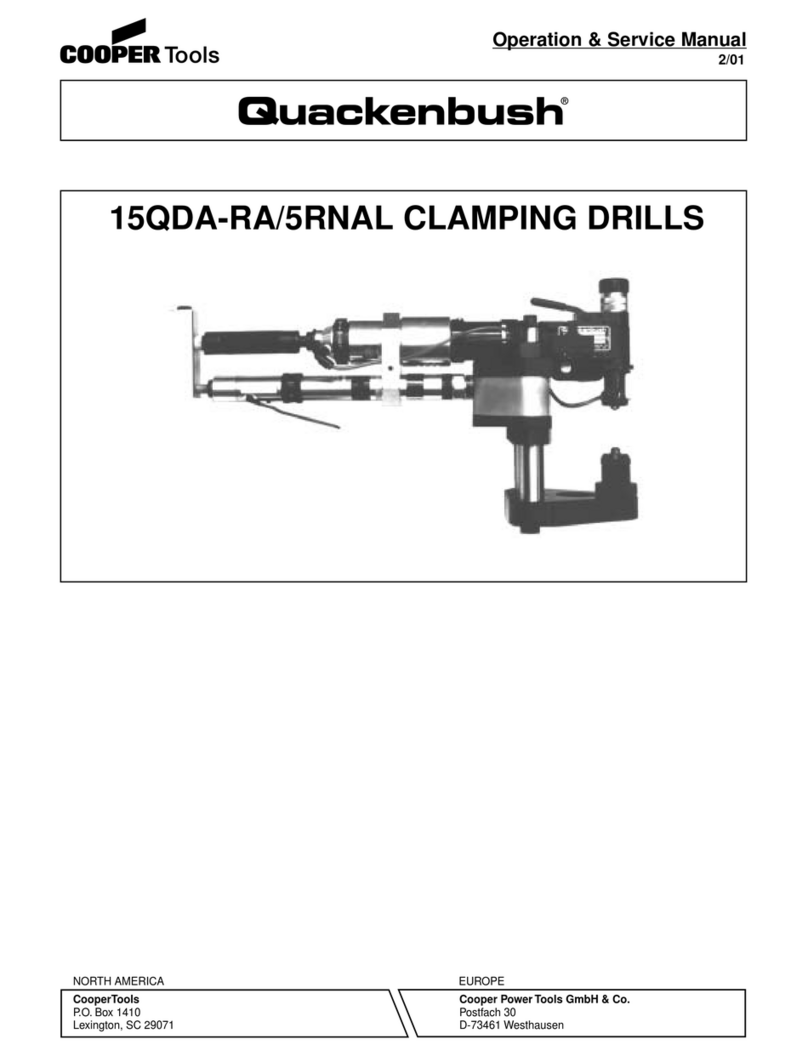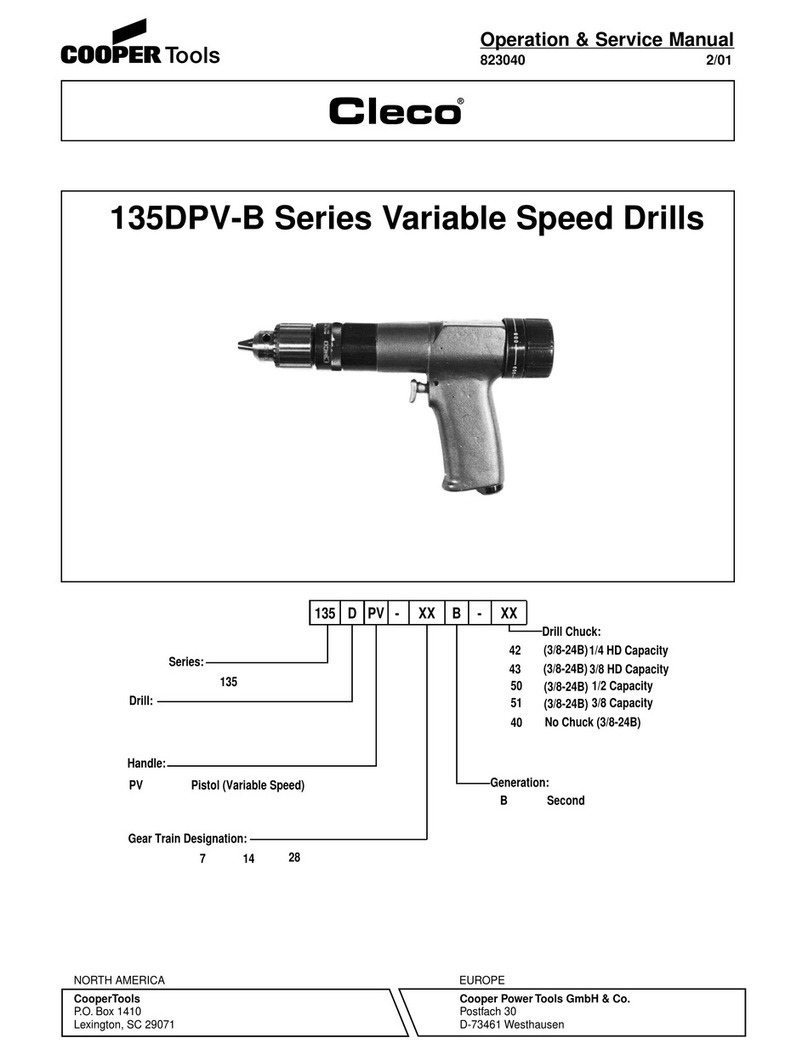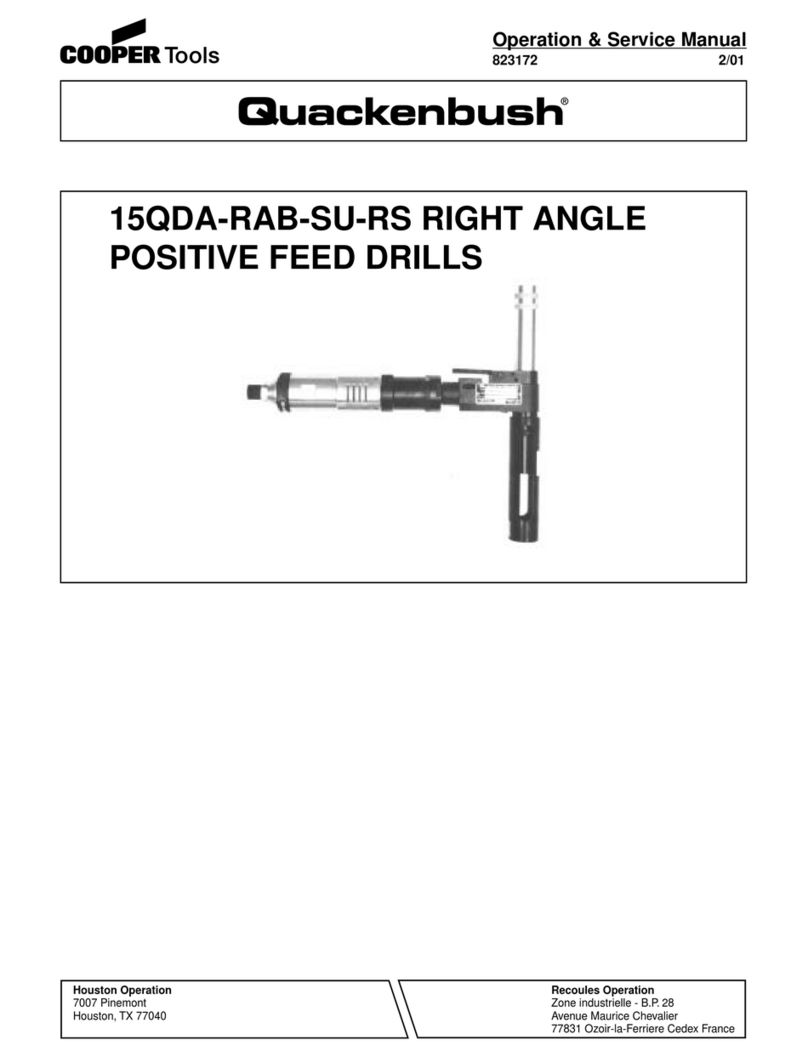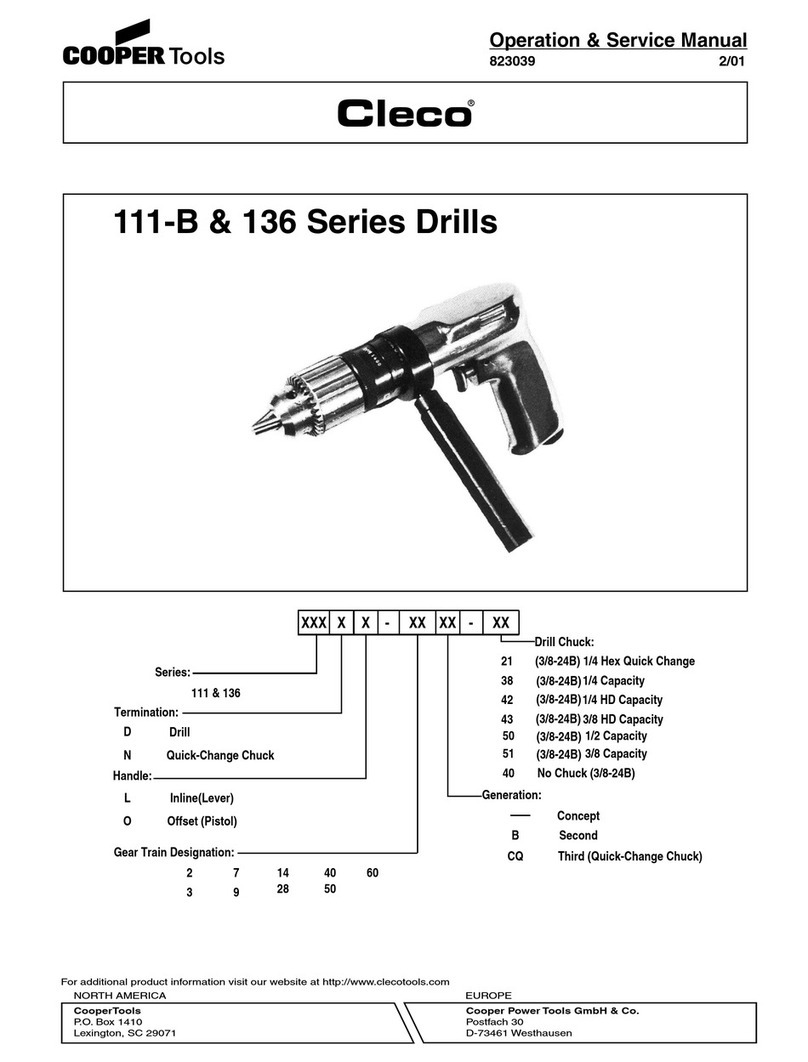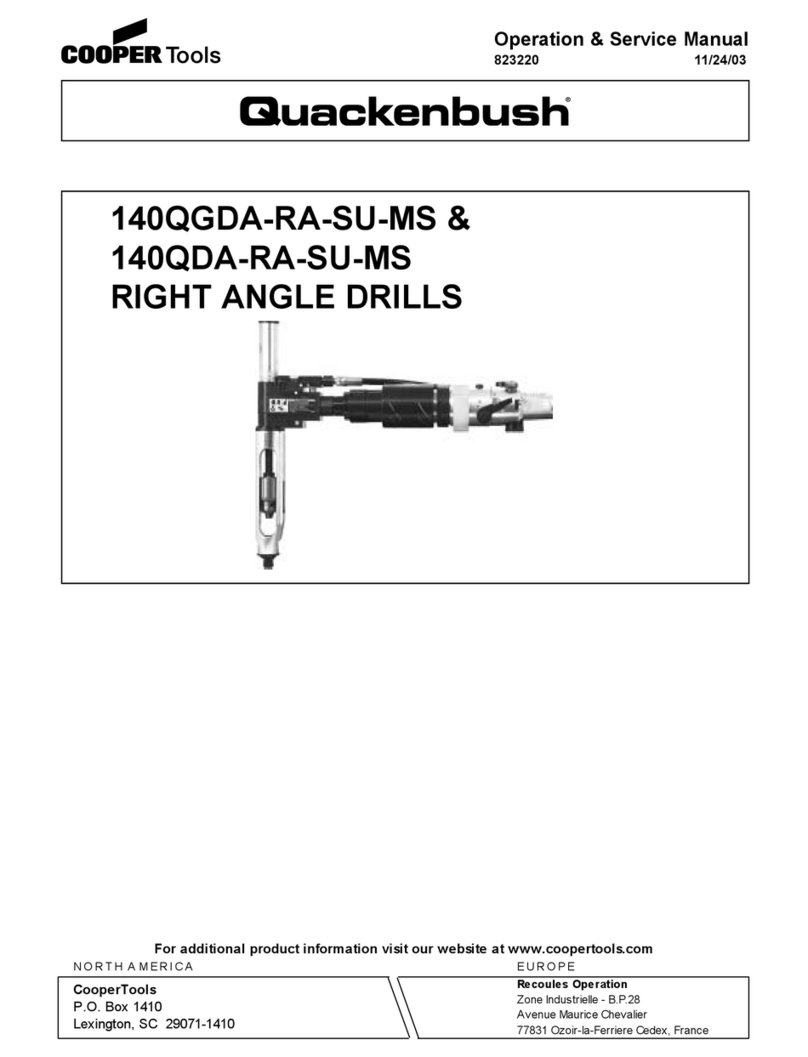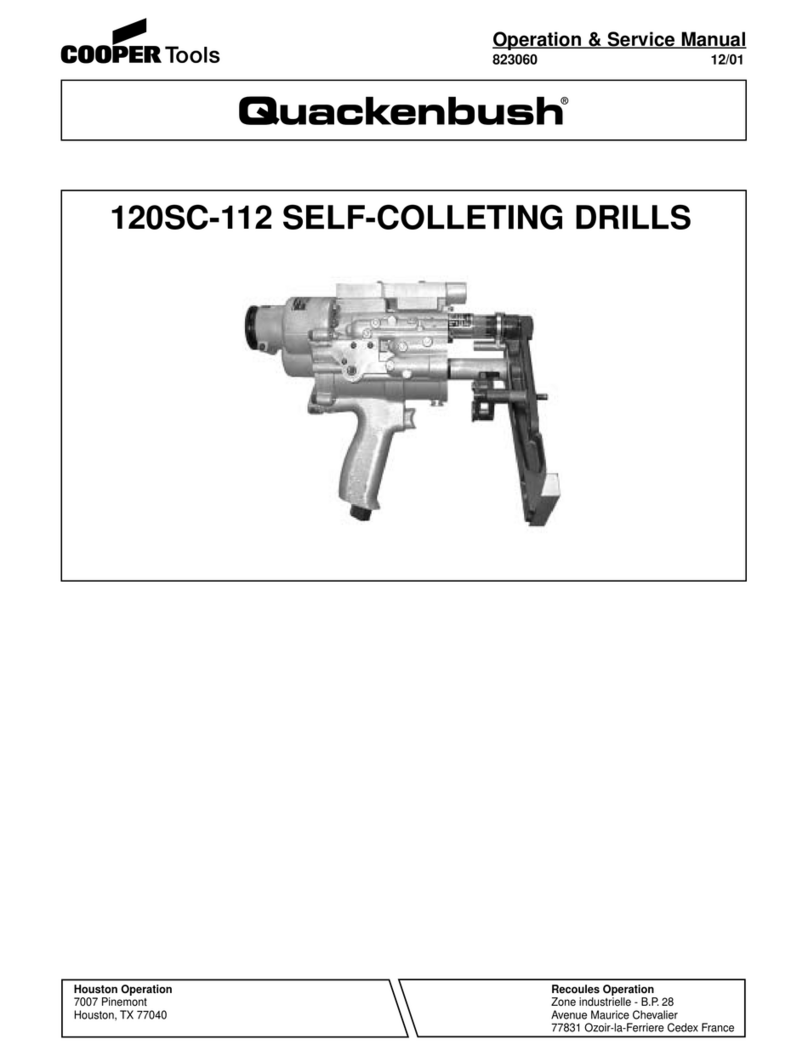
7
The180SC-225 isair operated,hydraulically controlled tool
thatautomaticallyclamps tothe material, drillsand counter-
sinks close tolerance holes in one operation. The 180S will
produce high quality holes in aluminum, steel, titanium and
petroleum hybrid materials primarily found in the aircraft/
aerospaceindustries.The180Sself-colletingdrillmotorhas
been designed using state-of-the-art technology that pro-
vides maximum power,minimum weight and the highest
degreeofaccuracyfordemandingholepreparationrequire-
ments.
Technical Data
Feed Stroke: Feed stroke of the 180SC-225 is 2.25 inches
to drill and countersink in 2 inch stacked material. The feed
stroke is unaffected by the collet stroke.
Collet Stroke: The 180SC-225 will clamp throughout its
.875 inch stroke. Feed stroke is unaffected by collet stroke.
Spindle Adjustment: The spindle adjustment of .375 inch
allows for drill length variations. See Spindle Adjustment
information on page 25.
Countersink Depth Control: A micrometer adjustment
provides for countersink stop repeatability within .001 inch.
Cutter Sizes: The 180SC-225 will accommodate .500 di-
ameter drills and.875 countersink diameter.
FeedRate:Anadjustabledrillfeedratemechanismenables
the 180SC-225 to drill from 5 seconds per inch to 1 minute
perinch.SeeFeedRateAdjustmentinformationonpage25.
Cutter to Collet Spacing: The cutter to collet distance is
adjustable between 1.00 inch minimum to 3.50 inch maxi-
mum.
Coolant:The180SC-225hasadrillpointcoolantportinthe
pressure foot. A coolant mist lubricator is available (See
Accessories Page 32-38)
Air Motor: The air motor for the 180SC-225 is rated at 1.8
horsepower nominal when supplied with air at 90 p.s.i.
AirConsumption:Airconsumptionofthe180SC-225is68
c.f.m. at 90 p.s.i. dynamic.
Weight:180SC-225weightwiththealuminumpressurefoot
is 14.9 pounds.
Spindle Speeds: Eleven geared spindle speeds are avail-
able with the 180S: 240, 420, 650, 850,1050, 2000, 3100,
4900, 6300, 12500 and 21000 RPM. See pages 31 and 32
for gear set assembly configurations.
TriggerLock:Atriggerlockisprovidedwhichallowsthetool
to be locked in the "Operate" position. With the lock acti-
vated, the tool will run through the clamp, feed and retract
cycles, but it will not unclamp or stop the motor until the
trigger lock is manually released.
Tool Start-Up
The180SC-225 drill isshipped from the factory equipped to
the customer's specifications: spindle RPM, spindle to ac-
commodate cutter type desired, pressure foot type, collet
guide to accommodate collet desired and optional booster
pump (if required).
After unpacking, examine the customer-specified equip-
ment on the 180SC-225 tool to verify type and speed of
components. Attach air line to 3/8-18 NPT inlet bushing. If
quick disconnect fittings are used, 3/8 in. ID are minimum.
The 180SC-225 drill requires a supply of clean 90-100 PSI
air. Air consumption is 45 CFM at 90 PSI. The use of the in-
line lubricator will provide the proper lubrication for the air
motorand willsignificantly increasethe tool life expectancy.
Because O-rings are extensively used to seal systems
within the tool, the elimination of foreign particles and other
contaminants will reduce the possibility of damage to these
parts. Always inspect O-rings for damage or wear and
replace as required. The use of silicone O-ring lubricant is
strongly recommended during reassembly. The addition of
oilintheairlinewillalsoincreasemotorandvalvelifeaswell
asthelifeoftheO-rings.Avoidtheuseofsyntheticlubricants
to prevent damage to O-rings and seals.
Introduction and General Information
WEIGHT
AIR CONSUMPTION
HORSE POWER
O/A LENGTH
STROKE
COLLET STROKE
COUNTERSINK
FEED RATE
SPINDLESPEEDS
DRILLING THRUST
CLAMPFORCE
SPINDLEADJUSTMENT
MAX. DRILL SIZES
COLLET FOOT SPACING
SPINDLE
COOLANT
180SC-225-14.0 LBS. MAX. W/ALUMINUM FOOT
68 C.F.M. @ 90 P.S.I. DYNAMIC
APPROX. 180S-1.4 @ 90 P.S.I.
180S-15.28 IN. MAX AT FULL EXTENSION
2.225 IN. (DRILL & C/SINK 2 IN. STACK)
.875 IN. (NO LOSS OF FEED STROKE)
COUNTERSINK STOP REPEATS WITHIN .001 IN.
MIN. 5 SEC. PER INCH, MAX 1 MIN. PER INCH
240, 420, 650, 850, 1050, 2000, 3100,
4900,6300,12500,21000
300 LBS. MAX. (WITHOUT BOOSTER PUMP)
548 LBS. START CLAMP STROKE (UNREGULATED AIR)
460 LBS. FULL CLAMP STROKE (UNREGULATED AIR)
.375 IN. ADJUSTMENT TO ALLOW FOR DRILL LENGTH
VARIATIONS
.500DRILL/.875C/SINK
1.00 IN. MIN. - 3.50 IN. MAX.
.500 IN. DIA. W1/4-28 & 3/8-16 O.D. THD OR 1/4-28 I.D. THD
THREAD TYPE DRILLS OR 1/4-28 TAPER-LOK TYPE DRILLS.
AIR BLAST PORT & DRILL POINT PORT IN TEMPLATE STD.,
COOLANT MIST LUBRICATOR AVAILABLE.
180SC-225 DRILL SPECIFICIATIONS
